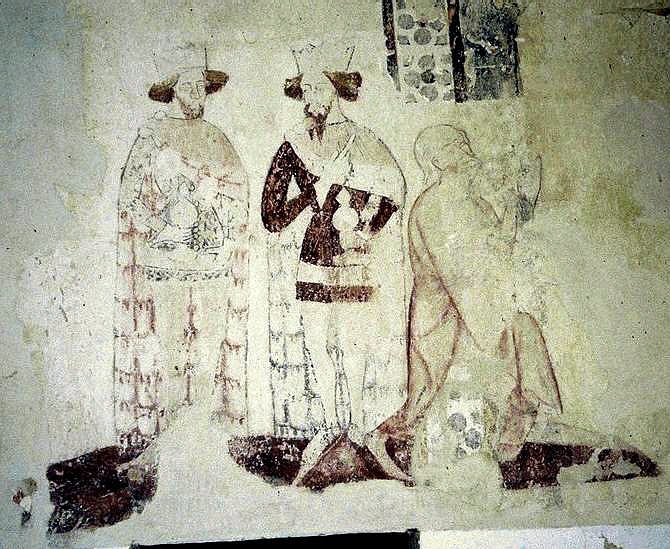Heydon, Norfolk (†Norwich) C14/15
The Adoration of the Magi

The Three Magi, or here as so often, Three Kings, are differentiated in age, with the middle-aged one in the centre, I think. Both he and his younger companion at the left have very short tunics, pointed shoes and gloves with gauntlets. Over this they wear long cloaks lined with vair or possibly in this case ermine, and this detail of the lining shows better here than in the cloaks of the royal persons in the Heydon Three Living & Three Dead on the north wall. Each of them holds his gift, and the middle-aged king is pointing upwards to the right of the group. The oldest king is already kneeling at the right, bare-headed and wrapped in his cloak. He has his hands raised, either to present his gift or in adoration. His crown was probably once on the ground beside him, a gesture of humility often seen in paintings of this subject.
The Magi have obviously reached the stable, but it is hard to be certain where Mary and the Christ Child were in relation to them. The painting is on the north wall of the south aisle, and the most likely place for the Bethlehem scene to be painted would have been on the east wall at a right angle to the Magi. Directly opposite them, on the south wall, is a large painting of a crowned female saint with long loose hair, possibly the Virgin herself or St Catherine. The south aisle may well have been used as a Lady Chapel in the Middle Ages, and there would probably have been an altar on its east wall. The piece of decorative border above the head of the kneeling king is slightly puzzling. It seems to have extended down the wall through the space where the king now is, which presumably makes it earlier than the painting of the Magi. One possibility is that it represented the entrance to the stable, which would accord well with the central king’s pointing gesture. But it seems to me more likely that a different subject entirely was painted here before the Adoration of the Magi was made.
As well as the Three Living & the Three Dead and the female saint, both mentioned and linked above, Heydon also has a very interesting painting of Herod’s Feast.